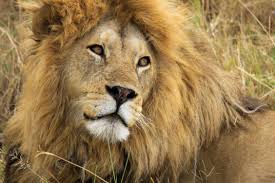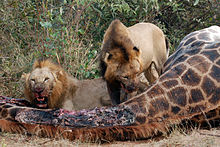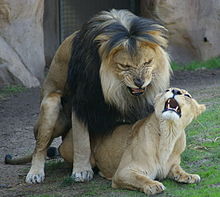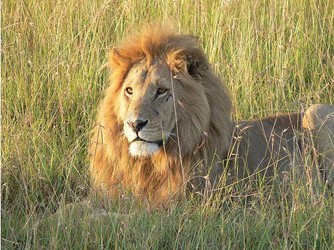
The lion is one of the big cats in the genus Panthera and a member of the family Felidae. The commonly used
term African lion collectively denotes the several subspecies in Africa. With some males exceeding 250 kg
(550 lb) in weight, it is the second-largest living cat after the tiger. Wild lions currently exist in
sub-Saharan Africa and in India (where an endangered remnant population resides in Gir Forest National Park).
In ancient historic times, their range was in most of Africa, including North Africa, and across Eurasia from
Greece and southeastern Europe to India. In the late Pleistocene, about 10,000 years ago, the lion was the most
widespread large land mammal after humans: Panthera leo spelaea lived in northern and western Europe and
Panthera leo atrox lived in the Americas from the Yukon to Peru. The lion is classified as a vulnerable
species by the International Union for Conservation of Nature (IUCN), having seen a major population decline
in its African range of 30-50% per two decades during the second half of the twentieth century. Lion populations
are untenable outside designated reserves and national parks. Although the cause of the decline is not fully
understood, habitat loss and conflicts with humans are the greatest causes of concern. Within Africa, the
West African lion population is particularly endangered.
In the wild, males seldom live longer than 10 to 14 years, as injuries sustained from continual fighting with
rival males greatly reduce their longevity. In captivity they can live more than 20 years. They typically
inhabit savanna and grassland, although they may take to bush and forest. Lions are unusually social compared to
other cats. A pride of lions consists of related females and offspring and a small number of adult males.
Groups of female lions typically hunt together, preying mostly on large ungulates. Lions are apex and keystone
predators, although they are also expert scavengers obtaining over 50 percent of their food by scavenging
as opportunity allows. While lions do not typically hunt humans, some have. Sleeping mainly during the day,
lions are active primarily at night (nocturnal), although sometimes at twilight (crepuscular).
Highly distinctive, the male lion is easily recognised by its mane, and its face is one of the most widely
recognised animal symbols in human culture. Depictions have existed from the Upper Paleolithic period, with
carvings and paintings from the Lascaux and Chauvet Caves in France dated to 17,000 years ago, through
virtually all ancient and medieval cultures where they once occurred. It has been extensively depicted in
sculptures, in paintings, on national flags, and in contemporary films and literature. Lions have been kept in
menageries since the time of the Roman Empire, and have been a key species sought for exhibition in zoos over
the world since the late eighteenth century. Zoos are cooperating worldwide in breeding programs for the
endangered Asiatic subspecies.
Characteristics
Of the living felids the lion is second only to the tiger in length and weight. Its skull is very similar to
that of the tiger, although the frontal region is usually more depressed and flattened, with a slightly shorter
postorbital region and broader nasal openings than that of a tiger. However, due to the amount of skull
variation in the two species, usually only the structure of the lower jaw can be used as a reliable indicator
of species. Lion colouration varies from light buff to yellowish, reddish, or dark ochraceous brown. The
underparts are generally lighter and the tail tuft is black. Lion cubs are born with brown rosettes (spots) on
their body, rather like those of a leopard. Although these fade as lions reach adulthood, faint spots often
may still be seen on the legs and underparts, particularly on lionesses.

Nowak indicates the typical weight range of lions as 150 to 250 kg (331 to 551 lb) for males and 120 to 185 kg
(265 to 408 lb) for females. The size of adult lions varies across their range with those from the southern
African populations in Zimbabwe, the Kalahari and Kruger Park averaging around 189.6 kg (418 lb) and 126.9 kg
(280 lb) in males and females respectively compared to 174.9 kg (386 lb) and 119.5 kg (263 lb) of male and
female lions from East Africa. Reported body measurements in males are head-body lengths ranging from 170 to
250 cm (5 ft 7 in to 8 ft 2 in), tail lengths of 90-105 cm (2 ft 11 in-3 ft 5 in). In females reported head-body
lengths range from 140 to 175 cm (4 ft 7 in to 5 ft 9 in), tail lengths of 70-100 cm (2 ft 4 in 3 ft 3 in),
however, the frequently cited maximum head and body length of 250 cm (8 ft 2 in) fits rather to extinct
Pleistocene forms, like the American lion, with even large modern lions measuring several centimetres less in
length. Record measurements from hunting records are supposedly a total length of nearly 3.6 m (12 ft) for a
male shot near Mucsso, southern Angola in October 1973 and a weight of 313 kg (690 lb) for a male shot outside
Hectorspruit in eastern Transvaal, South Africa in 1936. Another notably outsized male lion, which was shot
near Mount Kenya, weighed in at 272 kg (600 lb).
Mane
The mane of the adult male lion, unique among cats, is one of the most distinctive characteristics of the
species. In rare cases a female lion can have a mane. The presence, absence, colour, and size of the mane is
associated with genetic precondition, sexual maturity, climate, and testosterone production; the rule of thumb
is the darker and fuller the mane, the healthier the lion. Sexual selection of mates by lionesses favours
males with the densest, darkest mane. Research in Tanzania also suggests mane length signals fighting success
in male–male relationships. Darker-maned individuals may have longer reproductive lives and higher offspring
survival, although they suffer in the hottest months of the year.
Scientists once believed that the distinct status of some subspecies could be justified by morphology, including
the size of the mane. Morphology was used to identify subspecies such as the Barbary lion and Cape lion.
Research has suggested, however, that environmental factors such as average ambient temperature influence the
colour and size of a lion's mane. The cooler ambient temperature in European and North American zoos, for
example, may result in a heavier mane. Thus the mane is not an appropriate marker for identifying subspecies.
The males of the Asiatic subspecies, however, are characterised by sparser manes than average African lions.
In the Pendjari National Park area almost all males are maneless or have very weak manes. Maneless male lions
have also been reported from Senegal, from Sudan (Dinder National Park), and from Tsavo East National Park in
Kenya, and the original male white lion from Timbavati also was maneless. The testosterone hormone has been
linked to mane growth; therefore, castrated lions often have minimal to no mane, as the removal of the gonads
inhibits testosterone production. In addition, increased testosterone may be the cause of the maned lionesses
of northern Botswana.
Cave paintings of extinct European cave lions almost exclusively show animals with no manes, suggesting that
either they were maneless, or that the paintings depict lionesses as seen hunting in a group.
Behaviour
Lions spend much of their time resting and are inactive for about 20 hours per day. Although lions can be active
at any time, their activity generally peaks after dusk with a period of socialising, grooming, and defecating. Intermittent bursts of activity follow through the night hours until dawn, when hunting most often takes place. They spend an average of two hours a day walking and 50 minutes eating.
Group organisation
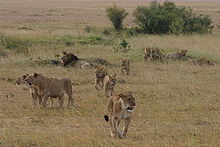
Lions are the most socially inclined of all wild felids, most of which remain quite solitary in nature. The lion
is a predatory carnivore with two types of social organization. Some lions are residents, living in groups of
related lionesses, their mates, and offspring. Such a group is called a pride. Females form the stable social
unit in a pride and do not tolerate outside females. Membership only changes with the births and deaths of
lionesses, although some females do leave and become nomadic. Although extremely large prides, consisting of up
to 30 individuals, have been observed, the average pride consists of five or six females, their cubs of both
sexes, and one or two males (known as a coalition if more than one) who mate with the adult females. The number
of adult males in a coalition is usually two but may increase to as many as four before decreasing again over
time. The sole exception to this pattern is the Tsavo lion pride which always has just one adult male. Male cubs
are excluded from their maternal pride when they reach maturity at around 2-3 years of age. The second
organizational behaviour is labeled nomads, who range widely and move about sporadically, either singularly
or in pairs. Pairs are more frequent among related males who have been excluded from their birth pride.
Note that a lion may switch lifestyles; nomads may become residents and vice versa. Males, as a rule, live at
least some portion of their lives as nomads, and some are never able to join another pride. A female who
becomes a nomad has much greater difficulty joining a new pride, as the females in a pride are related, and
they reject most attempts by an unrelated female to join their family group.
The area a pride occupies is called a pride area, whereas that by a nomad is a range. The males associated with
a pride tend to stay on the fringes, patrolling their territory. Why sociality the most pronounced in any cat
species has developed in lionesses is the subject of much debate. Increased hunting success appears an obvious
reason, but this is less than sure upon examination: coordinated hunting does allow for more successful
predation but also ensures that non-hunting members reduce per capita calorific intake; however, some take a
role raising cubs, who may be left alone for extended periods of time. Members of the pride regularly tend to
play the same role in hunts and hone their skills. The health of the hunters is the primary need for the
survival of the pride, and they are the first to consume the prey at the site it is taken. Other benefits
include possible kin selection (better to share food with a related lion than with a stranger), protection of
the young, maintenance of territory, and individual insurance against injury and hunger.
Lionesses do most of the hunting for their pride. They are more effective hunters, as they are smaller, swifter,
and more agile than the males and unencumbered by the heavy and conspicuous mane, which causes overheating
during exertion. They act as a coordinated group with members who perform the same role consistently in order
to stalk and bring down the prey successfully. Smaller prey is eaten at the location of the hunt, thereby
being shared among the hunters; when the kill is larger it often is dragged to the pride area. There is more
sharing of larger kills, although pride members often behave aggressively toward each other as each tries to
consume as much food as possible. Near the conclusion of the hunt, males have a tendency to dominate the kill
once the lionesses have succeeded. They are more likely to share this with the cubs than with the lionesses,
but males rarely share food they have killed by themselves.
hunting and diet
Lions prefer to scavenge when the opportunity presents itself with carrion providing more than 50% of their
diet. They scavenge animals either dead from natural causes (disease) or killed by other predators, and keep a
constant lookout for circling vultures, being keenly aware that they indicate an animal dead or in distress.
In fact, most dead prey on which both hyenas and lions feed upon are killed by the hyenas instead of the
lions.

The lionesses do most of the hunting for the pride. The male lion associated with the pride usually stays and
watches over young cubs until the lionesses return from the hunt. Typically, several work together and encircle
the herd from different points. Once they have closed in on the herd, they usually target the animal closest to
them. The attack is short and powerful; they attempt to catch the victim with a fast rush and final leap.
The prey usually is killed by strangulation, which can cause cerebral ischemia or asphyxia (which results in
hypoxemic, or "general", hypoxia). The prey also may be killed by the lion enclosing the animal's mouth and
nostrils in its jaws (which would also result in asphyxia).
Lions usually hunt in coordinated groups and stalk their chosen prey. However, they are not particularly known
for their stamina for instance, a lioness' heart makes up only 0.57% of her body weight (a male's is about
0.45% of his body weight), whereas a hyena's heart is close to 1% of its body weight. Thus, they only run fast
in short bursts, and need to be close to their prey before starting the attack. They take advantage of factors
that reduce visibility; many kills take place near some form of cover or at night. They sneak up to the victim
until they reach a distance of approximately 30 metres (98 feet) or less.
The prey consists mainly of medium-sized mammals, with a preference for wildebeest, zebras, buffalo, and
warthogs in Africa and nilgai, wild boar, and several deer species in India. Many other species are hunted,
based on availability, mainly ungulates weighing between 50 and 300 kg (110 and 660 lb) such as kudu,
hartebeest, gemsbok, and eland. Occasionally, they take relatively small species such as Thomson's gazelle or
springbok. Lions hunting in groups are capable of taking down most animals, even healthy adults, but in most
parts of their range they rarely attack very large prey such as fully grown male giraffes due to the danger of
injury. Giraffes and buffaloes are almost invulnerable to a solitary lion as well.
Reproduction and life cycle
Most lionesses will have reproduced by the time they are four years of age. Lions do not mate at any specific
time of year, and the females are polyestrous. As with other cats' penises, the male lion's penis has spines
that point backward. During withdrawal of the penis, the spines rake the walls of the female's vagina, which
may cause ovulation. A lioness may mate with more than one male when she is in heat.
The average gestation period is around 110 days, the female giving birth to a litter of one to four cubs in a
secluded den (which may be a thicket, a reed-bed, a cave, or some other sheltered area) usually away from the
rest of the pride. She will often hunt by herself while the cubs are still helpless, staying relatively close to
the thicket or den where the cubs are kept. The cubs themselves are born blind their eyes do not open until
roughly a week after birth. They weigh 1.2 - 2.1 kg (2.6 - 4.6 lb) at birth and are almost helpless, beginning
to crawl a day or two after birth and walking around three weeks of age. The lioness moves her cubs to a new
den site several times a month, carrying them one by one by the nape of the neck, to prevent scent from building
up at a single den site and thus avoiding the attention of predators that may harm the cubs.
Usually, the mother does not integrate herself and her cubs back into the pride until the cubs are six to eight
weeks old. Sometimes this introduction to pride life occurs earlier, however, particularly if other lionesses
have given birth at about the same time. For instance, lionesses in a pride often synchronise their reproductive
cycles so that they cooperate in the raising and suckling of the young (once the cubs are past the initial stage
of isolation with their mother), who suckle indiscriminately from any or all of the nursing females in the pride.
In addition to greater protection, the synchronization of births also has an advantage in that the cubs end up
being roughly the same size, and thus have an equal chance of survival. If one lioness gives birth to a litter
of cubs a couple of months after another lioness, for instance, then the younger cubs, being much smaller than
their older brethren, usually are dominated by larger cubs at mealtimes consequently, death by starvation is
more common among the younger cubs.
In addition to starvation, cubs also face many other dangers, such as predation by jackals, hyenas, leopards,
martial eagles, and snakes. Even buffaloes, should they catch the scent of lion cubs, often stampede toward the
thicket or den where they are being kept, doing their best to trample the cubs to death while warding off the
lioness. Furthermore, when one or more new males oust the previous male(s) associated with a pride, the
conqueror(s) often kill any existing young cubs, perhaps because females do not become fertile and receptive
until their cubs mature or die. All in all, as many as 80% of the cubs will die before the age of two.
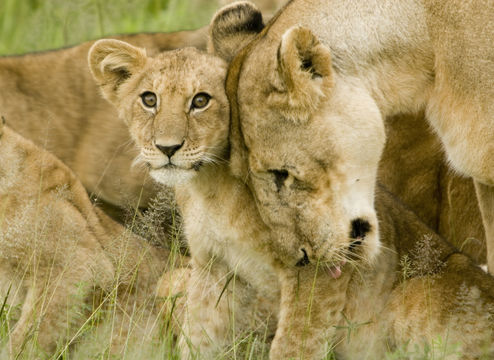
When first introduced to the rest of the pride, the cubs initially lack confidence when confronted with adult
lions other than their mother. They soon begin to immerse themselves in the pride life, however, playing among
themselves or attempting to initiate play with the adults. Lionesses with cubs of their own are more likely to
be tolerant of another lioness's cubs than lionesses without cubs. The tolerance of the male lions toward the
cubs varies sometimes, a male will patiently let the cubs play with his tail or his mane, whereas another may
snarl and bat the cubs away.
Weaning occurs after six to seven months. Male lions reach maturity at about 3 years of age and, at 4-5 years
of age, are capable of challenging and displacing the adult male(s) associated with another pride. They begin
to age and weaken between 10 and 15 years of age at the latest, if they have not already been critically
injured while defending the pride (once ousted from a pride by rival males, male lions rarely manage a second
take-over). This leaves a short window for their own offspring to be born and mature. If they are able to
procreate as soon as they take over a pride, potentially, they may have more offspring reaching maturity
before they also are displaced. A lioness often will attempt to defend her cubs fiercely from a usurping male,
but such actions are rarely successful. He usually kills all of the existing cubs who are less than two years
old. A lioness is weaker and much lighter than a male; success is more likely when a group of three or four
mothers within a pride join forces against one male.
Contrary to popular belief, it is not only males that are ousted from their pride to become nomads, although
most females certainly do remain with their birth pride. However, when the pride becomes too large, the next
generation of female cubs may be forced to leave to eke out their own territory. Furthermore, when a new male
lion takes over the pride, subadult lions, both male and female, may be evicted. Life is harsh for a female
nomad. Nomadic lionesses rarely manage to raise their cubs to maturity, without the protection of other pride
members.
Canadian researcher Bruce Bagemihl reports that both males and females may interact homosexually. Lions are
shown to be involved in group homosexual and courtship activities. Male lions will also head rub and roll
around with each other before simulating sex together.




